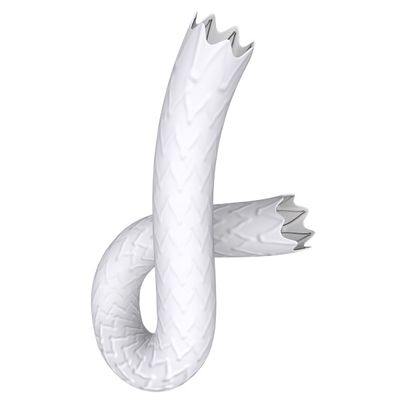

- Home
- Companies
- Bentley InnoMed GmbH
- Products
- BeGraft - Peripheral One-Layer Stent ...

BeGraft - Peripheral One-Layer Stent Graft System
This peripheral stent graft system excels with a high radial force whilst maintaining extraordinary flexibility and a low profile. The cobalt-chrome stent platform is covered with a micro-porous ePTFE membrane.
Non-clinical testing has demonstrated that the “BeGraft Peripheral Stent Graft” is MR Conditional. A patient with this device can be safely scanned immediately after implantation in an MR system meeting the following conditions:
- static magnetic field of 1.5 Tesla and 3 Tesla, with
- maximum spatial field gradient of 5,100 G/cm (51 T/m)
- maximum force product of 91,000,000 G²/cm (91 T²/m)
- theoretically estimated maximum whole body averaged (WBA) specific absorption rate (SAR) of 2 W/kg (normal operating mode)
Under the scan conditions defined above, the “BeGraft Peripheral Stent Graft” is expected to produce a maximum temperature rise of less than
- 2.7°C (2 W/kg, 1.5 Tesla) RF-related temperature increase with a background temperature increase of ≈ 1.4°C (2 W/kg, 1.5 Tesla)
- 2.1°C (2 W/kg, 3 Tesla) RF-related temperature increase with a background temperature increase of ≈ 1.0°C (2 W/kg, 3 Tesla)
after 15 minutes of continuous scanning.
The effect of heating in the MRI environment for overlapping stent grafts or stent grafts with fractured struts is not known. In non-clinical testing, the image artifact caused by the device extends approximately 12.4 mm from the “BeGraft Peripheral Stent Graft” when imaged with a gradient echo pulse sequence and a 3 Tesla MR system.
For further information, please see the current version of the IFUs.
The BeGraft Peripheral Stent Graft System is indicated for intraluminal chronic placement in iliac and renal arteries for:
- Restoring and improving the patency
- Treating aneurysms, acute perforations, acute ruptures and fistulas
The BeGraft Peripheral Stent Graft System is not available in the US.
